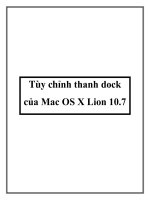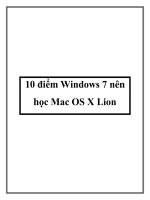Mac OS X Server Administration For Version 10.5 Leopard 2nd phần 5 ppsx
Bạn đang xem bản rút gọn của tài liệu. Xem và tải ngay bản đầy đủ của tài liệu tại đây (374.34 KB, 24 trang )
Chapter 5 Installation and Deployment 97
Use command-line arguments that apply to your specific needs. The following
command is a sample, which creates a single mirrored RAID set (RAID 1) from the first
two disks installed in the computer (disk0 and disk1), with the resulting RAID volume
called MirrorData.
The basic syntax is:
diskutil createRAID mirror setName format device device
So the command is:
diskutil createRAID mirror MirrorData JournaledHFS+ disk0 disk1
Erasing a Disk or Partition
You have several options for erasing as disk, depending on your preferred tools and
your computing environment:
 Erasing a Disk Using the Installer: You can erase a disk or partition while using the
Mac OS X Server Installer. When you select the target volume in the Installer, you can
also select an option to have the target disk or partition erased during installation
using the Mac OS Extended (Journaled) format. This is the most recommended
format for a Mac OS X Server startup volume.
 Erasing a Disk Using Disk Utility: You can use the Installer to open the Disk Utility
application and then use it to erase the target volume or another volume. You can
erase the target volume using the Mac OS Extended format or Mac OS Extended
(Journaled) format. You can erase other volumes using either of those formats,
Mac OS Extended format (Case-Sensitive) format, or Mac OS Extended (Journaled,
Case-Sensitive) format.
You can erase but not partition a disk or partition while using the Mac OS X Server
Installer. When you select the target volume in the Installer, you can also select an
option to have the target disk or partition erased during installation using the Mac
OS Extended (Journaled) format. This is the recommended format for a Mac OS X
Server startup volume.
You can find instructions for partitioning the hard disk into multiple volumes,
creating a RAID set, and erasing the target disk or partition by viewing Disk Utility
Help. To view Disk Utility Help, open Disk Utility on another Macintosh computer
with Mac OS X v10.5 and choose Help > Disk Utility Help.
 Erasing a Disk Using the Command-line: Finally you can use the command-line to
erase disks using the tool diskutil. Erasing a disk using diskutil results in losing all of
the volume partitions. The command to erase a complete disk is:
diskutil eraseDisk format name [OS9Drivers | APMFormat | MBRFormat |
GPTFormat] device
For example:
diskutil eraseDisk JournaledHFS+ MacProHD GPTFormat disk0
98 Chapter 5 Installation and Deployment
There is also an option to securely delete data by overwriting the disk with random
data multiple times. For more details, see diskutil’s man page.
To erase a single volume on a disk, a slightly different command is used:
diskutil eraseVolume format name device
For example:
diskutil eraseVolume JournaledHFS+ UntitledPartition /Volumes/
OriginalPartition
Additional information about diskutil and other uses can be found in Command-Line
Administration. For complete command syntax for diskutil, consult the tool’s man page.
Identifying Remote Servers When Installing Mac OS X Server
For remote server installations, you need to know this information about the target
server:
 The identity of the target server: When using Server Assistant, you must be able to
recognize the target server in a list of servers on your local subnet or you must enter
the IP address of the server (in IPv4 format: 000.000.000.000) if it resides on a
different subnet. Information provided for servers in the list includes IP address, host
name, and Media Access Control (MAC) address (also called hardware or Ethernet
address).
If you use VNC viewer software to remotely control installation of Mac OS X Server
v10.5 or later, it may let you select the target server from a list of available VNC
servers. If not, you must enter the IP address of the server (in IPv4
format: 000.000.000.000).
The target server’s IP address is assigned by a DHCP server on the network. If no
DHCP server exists, the target server uses a 169.xxx.xxx.xxx address unique among
servers on the local subnet. Later, when you set up the server, you can change the IP
address.
If you don’t know the IP address and the remote server is on the local subnet, you
can use the sa_srchr command to identify computers on the local subnet where you
can install server software. Enter the following from an existing computer with
Mac OS X Server Tools installed:
/System/Library/Serversetup/sa_srchr 224.0.0.1
This command will return the IP address, and the EthernetID (in addition to other
information) of servers on the local subnet which have started up from the
installation disk.
 The preset password for the target server: The password consists of the first eight
digits of the server’s built-in hardware serial number. To find a server’s serial number,
look for a label on the server. Older computers have no built-in hardware serial
numbers; for these systems, use 12345678.
Important:
Important:
WARNING:
installer
 Command-Line Administration
 installer installer -help man
installer
Â
Â
ssh root@<ip address>
∏
sa_srchr
/System/Library/Serversetup/sa_srchr 224.0.0.1
mycomputer.example.com#PowerMac4,4#<ip address>#<mac address>#Mac OS X
Server 10.5#RDY4PkgInstall#2.0#512
/usr/sbin/installer -volinfo -pkg /System/Installation/Packages/
OSInstall.mpkg
/usr/sbin/installer -volinfo -pkg /Volumes/ServerNetworkImage10.5/
System/Installation/Packages/OSInstall.mpkg
/Volumes/Mount 01
/Volumes/Mount1
/Volumes/Mount02
installer
diskutil
/usr/sbin/diskutil eraseVolume HFS+ "Mount 01" "/Volumes/Mount 01"
/usr/sbin/diskutil enableJournal "/Volumes/Mount 01"
diskutil
diskutil
Important:
/usr/sbin/installer -verboseR -lang en -pkg /System/Installation/
Packages/OSInstall.mpkg -target "/Volumes/Mount 01"
/sbin/reboot
/sbin/shutdown -r
installer
installer
installer
Â
Â
Â
Â
Â
Â
 softwareupdate
Â
Â
Â
Â
m
Command-
Line Administration
Â
Â
Â
Â
Â
Â
Â
Â
Â
Â
Â
Â
Upgrading and Migrating
Open Directory Administration.
Â
Â
Â
Note:
Open Directory Administration
after
Open Directory
Administration
Upgrading and Migrating
Â
Â
Â
Open Directory
Administration
Â
Â
Â
Â
Â
Â
Â
Â
Â
Â
Â
Â
Step 1: Create the setup data files
Â
Â
Â
Â
Step 2: Make the setup data files available to a freshly installed server
Â
Â
Â
any
Important:
Â
Â
Â
serversetup -setServerSerialNumber
Â
serversetup -setServerSerialNumber
Open Directory
Administration
Â
Â
Network
Services Administration
Â
Â









